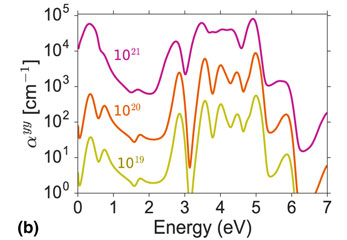Crossref Citations
This article has been cited by the following publications. This list is generated based on data provided by
Crossref.
Cui, Yuanyuan
Wang, Qinfan
and
Gao, Yanfeng
2020.
Optical properties of doping electrochromic M0.125W0.875O3 (M=Mo, Nb, Ta, Ti, V): A first-principles study.
Materials Today Communications,
Vol. 25,
Issue. ,
p.
101611.
Lee, Jounghee
Nahm, Ho-Hyun
and
Kim, Yong-Hyun
2020.
Diversity of hole-trap centers due to small polarons and bipolarons in Ca-doped
BiFeO3
: Origin of electrochromism.
Physical Review B,
Vol. 101,
Issue. 1,
Jiang, Yuanwei
Cao, Shuangying
Lu, Linfeng
Du, Guanlin
Lin, Yinyue
Wang, Jilei
Yang, Liyou
Zhu, Wenqing
and
Li, Dongdong
2021.
Post-annealing Effect on Optical and Electronic Properties of Thermally Evaporated MoOX Thin Films as Hole-Selective Contacts for p-Si Solar Cells.
Nanoscale Research Letters,
Vol. 16,
Issue. 1,
Huang, Qingjiao
Wang, Jiajun
Gong, Hui
Zhang, Qianqian
Wang, Mengying
Wang, Wenwen
Nshimiyimana, Jean Pierre
and
Diao, Xungang
2021.
A rechargeable electrochromic energy storage device enabling effective energy recovery.
Journal of Materials Chemistry A,
Vol. 9,
Issue. 10,
p.
6451.
Cui, Yuanyuan
Wang, Qinfan
Yang, Guang
and
Gao, Yanfeng
2021.
Electronic properties, optical properties and diffusion behavior of WO3 with H+, Li+ and Na+ intercalated ions: A first-principles study.
Journal of Solid State Chemistry,
Vol. 297,
Issue. ,
p.
122082.
Meng, Yue
Li, Zixu
and
Liu, Zhifeng
2022.
Enhanced electrochromic properties of inorganic–organic tungsten oxide and Prussian blue core–shell film.
Journal of Materials Science: Materials in Electronics,
Vol. 33,
Issue. 33,
p.
24995.
Hawkins, Brendan E.
Turney, Damon E.
Messinger, Robert J.
Kiss, Andrew M.
Yadav, Gautam G.
Banerjee, Sanjoy
and
Lambert, Timothy N.
2022.
Electroactive ZnO: Mechanisms, Conductivity, and Advances in Zn Alkaline Battery Cycling.
Advanced Energy Materials,
Vol. 12,
Issue. 15,
Uji, Shun
Kimura, Shunsuke
Nakamura, Kazuki
and
Kobayashi, Norihisa
2023.
Analysis for coloration mechanism of reversible silver deposition-based electrochromic device by in situ observation of plasmonic nanoparticles with dark-field microscopy.
Solar Energy Materials and Solar Cells,
Vol. 251,
Issue. ,
p.
112119.
Xu, Siyuan
Liu, Zheng
Xu, Xun
Guo, Yuzheng
Wei, Su-Huai
and
Zhang, Xie
2024.
PyArc: A python package for computing absorption and radiative coefficients from first principles.
Computer Physics Communications,
Vol. 305,
Issue. ,
p.
109352.
Li, Jingjie
Kang, Qian
Wang, Yanhao
Zhou, Zixiao
Sun, Zhaoqing
Zhang, Hai
Lu, Wanyu
Tao, Xianglin
Zhang, Shan‐Ting
Chen, Xiaoqing
Zheng, Zilong
Yan, Hui
Li, Dongdong
and
Zhang, Yongzhe
2024.
Low Oxygen Content MoOx and SiOx Tunnel Layer Based Heterocontacts for Efficient and Stable Crystalline Silicon Solar Cells Approaching 22% Efficiency.
Advanced Functional Materials,
Vol. 34,
Issue. 6,
Rowberg, Andrew J. E.
and
Van de Walle, Chris G.
2024.
Defect Properties, Anion Ordering, and Photochromic Mechanism in Yttrium Oxyhydride.
The Journal of Physical Chemistry C,
Vol. 128,
Issue. 47,
p.
20387.
